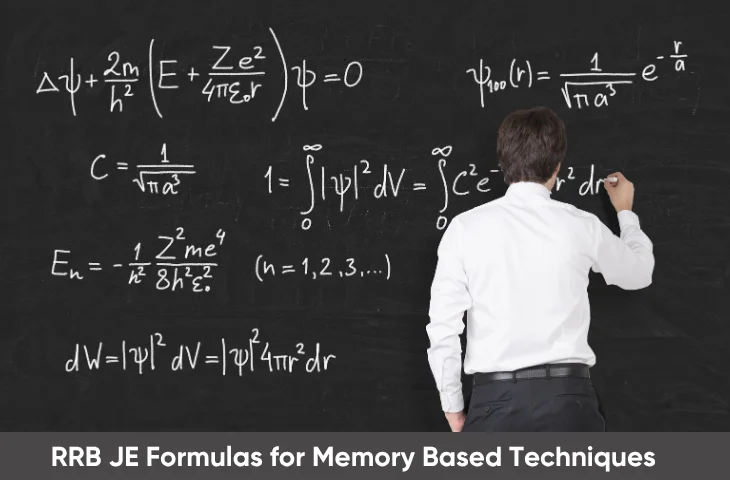RRB JE Formulas: Memorizing formulas is one of the biggest challenges for RRB JE aspirants. With numerous engineering branches like Civil, Electrical, Mechanical, and S&T, it’s easy to forget key formulas under exam pressure. The Memory Place Technique (also called the “Method of Loci”) is a proven mental strategy that can help candidates memorize and recall formulas quickly and effectively.
What is the Memory Place Technique?
The Memory Place Technique is a mnemonic method where you associate information with familiar locations or ‘mental places’. Instead of rote memorisation, you create a mental journey through a location you know well (like your home, a park, or your route to college) and place formulas along the path. The reason why it works for RRB JE formulas is given below:
- Engages visual memory, which is stronger than plain text memory.
- Reduces the stress of remembering multiple formulas.
- Enhances recall speed during exams.
How to Apply the Memory Place Technique for RRB JE?
Given below are the steps to apply the memory place techniques for RRB JE:
Step 1: Choose Your Memory Place
- Pick a familiar environment, e.g., your home, workplace, or favourite park.
- Divide it into distinct locations (e.g., rooms, furniture, landmarks).
Step 2: Assign Formulas to Locations
- Place each formula at a specific spot.
- Example: Living room → Ohm’s Law, Bedroom → Kinematic formulas, Kitchen → Thermal formulas.
Step 3: Visualize and Connect
- Imagine the formula interacting with the object.
- Example: For ( F = ma ), imagine pushing a heavy sofa in your living room (force = mass × acceleration).
Step 4: Rehearse Your Mental Journey
- Walk through your mental path several times.
- Visualize formulas at their assigned spots every day.
Step 5: Recall During Practice
- While solving practice questions, mentally “walk” through your memory place to retrieve formulas.
Examples of Memory Place Technique for RRB JE Formulas
It is very important to understand the memory place techniques for RRB JE Formulas. Certain examples from the RRB JE Syllabus are given below:
| Branch | Formula Example | Memory Place Idea |
| Mechanical | ( F = ma ) (Force) | Living room sofa → imagine pushing |
| Civil | ( A = \pi r^2 ) (Area) | Bedroom table → round rug as circle |
| Electrical | ( V = IR ) (Ohm’s Law) | Kitchen stove → wires imagined running |
| S&T | ( f = \frac{v}{\lambda} ) (Wave formula) | Balcony → waves of wind hitting railing |
| Thermal | ( Q = mc\Delta T ) | Water tank in terrace → heating water |
Benefits of Using This Technique for RRB JE Formulas
There are various benefits of using this technique for RRB JE Exam 2025. Some of them are given below:
- Faster Memorization: Less time spent on rote learning.
- Better Retention: Mental imagery helps long-term memory.
- Reduced Exam Anxiety: Confidence in recalling formulas under pressure.
- Applicable Across Subjects: Works for Physics, Mechanics, Electrical, Civil, and S&T formulas.
Additional Tips for Memorizing RRB JE Formulas
We have given below certain tips for the RRB JE Exam Aspirants 2025. Check out the details below:
- Break formulas into groups by subject or type.
- Combine Memory Place Technique with flashcards for revision.
- Practice daily mental walkthroughs to strengthen recall.
- Test yourself by solving numerical problems using formulas from memory.
Summary of RRB JE Formulas
The below given points summarizes the memory based techniques for RRB JE Formulas. Check them out for a quick overview:
- Memorizing formulas is a major challenge in RRB JE preparation, but the Memory Place Technique makes it easier.
- By assigning formulas to familiar locations and using vivid mental imagery, aspirants can recall formulas quickly and confidently.
- This method improves retention, reduces anxiety, and enhances exam performance, making it a valuable tool for all technical branches.
The Memory Place Technique is a practical, efficient, and fun way to remember RRB JE formulas. By combining visualization, imagination, and structured practice, aspirants can master a large number of formulas across Mechanical, Civil, Electrical, and S&T branches. Regular use of this technique not only boosts confidence during exams but also enhances overall problem-solving speed and accuracy.
FAQs
The Memory Place Technique (Method of Loci) involves associating formulas with familiar locations in your mind. It helps aspirants memorize and recall RRB JE formulas quickly by creating a mental map, reducing reliance on rote learning
Yes. The technique works for any technical branch, including Civil, Mechanical, Electrical, Thermal, and S&T, by assigning formulas to different “mental spots” in your chosen memory place.
There’s no strict limit. You can assign as many formulas as needed by expanding your mental location, e.g., different rooms, furniture, or landmarks. The key is consistent visualization and practice.
Daily practice is recommended. Walking through your mental journey multiple times each day strengthens recall and ensures formulas are remembered under exam conditions.
Absolutely. By mentally “walking” through your memory place, you can retrieve formulas instantly while solving numerical or theoretical problems, improving speed, accuracy, and confidence.
- RRB JE Vacancy 2025 Out, Check New Vacancies for 2,588 Posts
- रेलवे परीक्षा की तैयारी करें, सारी जानकारी यहां देखें
- Why RRB JE Mechanical and Electrical Post is Best for Selection?
- Important RRB JE Computer Questions, Know Difficulty Level
- How RRB JE 2025 Preparation Can Help You Crack PSU, SSC JE?
- Benefits of Preparing RRB JE Notes, Know the Topics to Focus

Hello! This is Arijit Dutta. I am a skilled Content Writer at Oliveboard with nearly 3+ years of experience in crafting engaging, informative, and exam-focused content for the Railways Domain. With a strong command of language and a keen understanding of learner needs, I contribute significantly to Oliveboard’s mission of delivering high-quality educational resources. Passionate about clear communication and continuous learning, I consistently create content that helps government job aspirants achieve their goals. Outside of work, I enjoy playing cricket and listening to music, which helps me stay balanced and creative in my professional journey.
